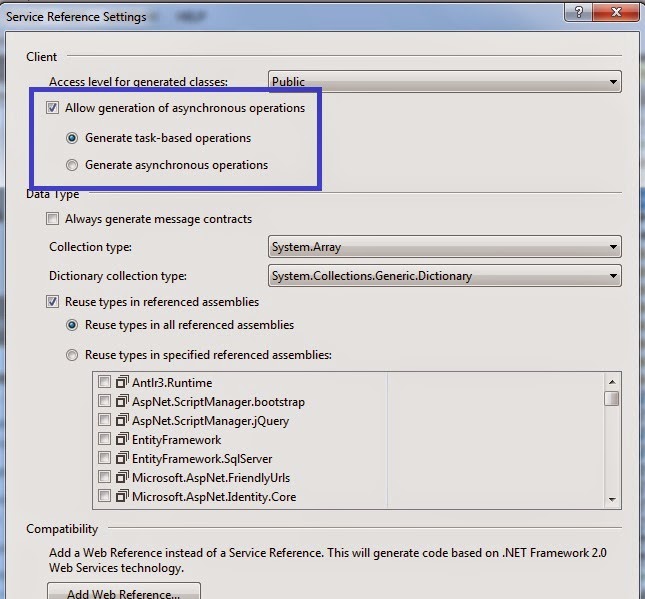In this part of WCF Tutorial series, we are going to implement "
Task based programming model" feature of
Windows Communication Foundation v4.5.
Asynchronous programming has undoubtedly overcome application performance issues and also make application more responsive but as a developer for many, this approach has always been a little complex.
In WCF 4.5, Microsoft introduced support for Task-based programming model based on TAP (Task-based Asynchronous Pattern) that is comparatively easy to implement, because most of the difficult work of developer is now moved to compiler. For a detailed reference to Asynchronous Programming in WCF 4.5, please follow here.
In this WCF Tutorial, we are going to see task-based asynchronous operations in action. Two important keywords "async" and "await" are used for task-based asynchronous programming.
Consider we have a WCF Service as follows:
namespace SimpleTaskBasedWCFService
{
[ServiceContract]
public interface IStudentService
{
[OperationContract]
List<Student> GetStudents();
}
[DataContract]
public class Student
{
[DataMember]
public int StudnetId { get; set; }
[DataMember]
public string StudentName { get; set; }
}
}
Our WCF Service implementation is as below:
public class StudentService : IStudentService
{
List<Student> students = null;
public List<Student> GetStudents()
{
students = new List<Student> {
new Student(){StudnetId=1, StudentName="Imran"},
new Student(){StudnetId=2, StudentName="Nauman"},
new Student(){StudnetId=3, StudentName="Salman"}
};
return students;
}
}
Now, let's compile and publish the WCF Service. So far things are same as we do normally for creating a WCF Service.
But if we have a client application and add a reference to this service using Visual Studio 2012 or higher with .NET 4.5, we will see the difference.
If we click on "Advanced..." button above, the following screen will be displayed and we can find the option for "Generate task-based operations" as marked below:

If we generate proxy with above selected option, we will see asynchronous method "GetStudentsAsync" as shown below:

The calling method from client will be using "async" and "await" keywords as displayed in the below code:
protected async void btnGetStudents_Click(object sender, EventArgs e)
{
lblMessage.Text = "Fetching students data....";
MyStudentService.StudentServiceClient client = new MyStudentService.StudentServiceClient();
var Result = await client.GetStudentsAsync();
gvStudents.DataSource = Result;
gvStudents.DataBind();
lblMessage.Text = "Students data fetched successfully.";
}
As compared to traditional asynchronous approach, task-based asynchronous operation is much easier in WCF 4.5 especially due to the following factors:
- Proxy generated with
Async automatically - Client code is straight forward using
async and await keywords instead of callback methods
Hopefully, we will continue exploring more features of WCF 4.5 in later posts.
Previous <<< New Features in WCF 4.5 - Part 3
Other Related Tutorials That Might Be Of Interest
